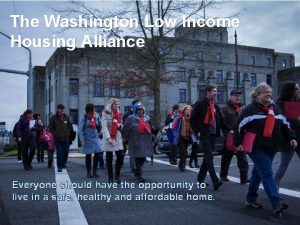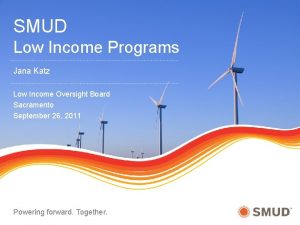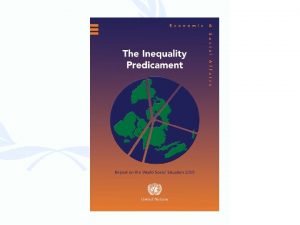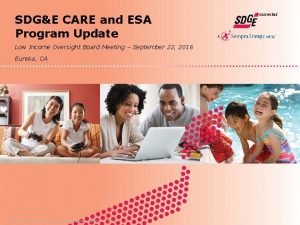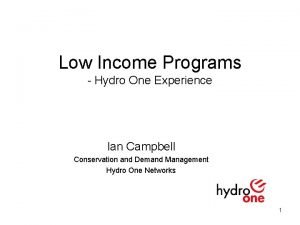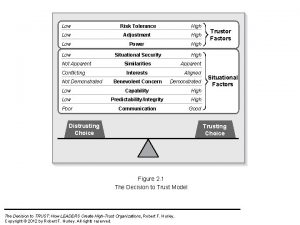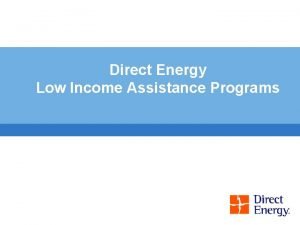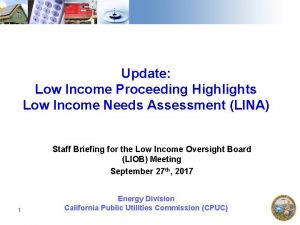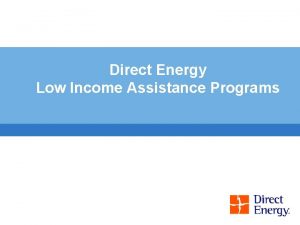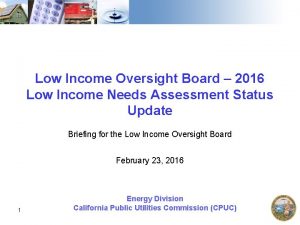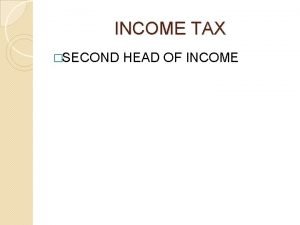LOW INCOME SOLUTIONS IN A HIGH DER FUTURE













- Slides: 13

LOW INCOME SOLUTIONS IN A HIGH DER FUTURE A POTENTIAL e. LAB INITIATIVE RMI. Creating a clean, prosperous, and secure energy future. TM

OVERVIEW • Thesis: – Low income and fixed income (LI/FI) customers are critical segments that are at risk in a transition towards a more distributed and renewable electricity system. – To enable a successful transition to this future, the concerns of these customers must be addressed. • Guiding Questions – What are the characteristics and concerns of LI/FI customers? – In what ways are these concerns at odds with a highly renewable and distributed electricity system? – What solutions already exist that could be the focus of scaling or replication? – What are the unmet needs and how can they be addressed? – What role can e. Lab play? 2

LOW AND FIXED INCOME CUSTOMER SEGMENTS Low Income (LI) • Often fall below 150 -200% of poverty level as defined by US Census (ex. $36, 000 for a family of four) • 10 million low income families in the US • LI communities have a history of being politically and economically marginalized Both groups • Geographically diverse and live in both single- and multi-family homes • Spend as high as 20% of income on energy • Have diverse energy use profiles and may have difficulty shifting usage Fixed Income (FI) • Live on income that does not increase annually (such as pensions) • 40 million individuals 65 or older live in the US • • 50% of seniors live at or below 250% of poverty level 1 million social security disability awards in 2013 1. Ensuring New York Solar Programs reach low-income residents. Jospe C. et. al. 2014. 3. National Council on Aging. http: //www. ncoa. org/press-room/fact-sheets/economic-security-for. html. 4. Social Security Administration. http: //www. ssa. gov/OACT/STATS/dib. Stat. html. 2. Unlocking Energy Efficiency for Low-Income Utility Customers. Opower. 2014. 3

CONSUMER ADVOCATE CONCERNS Financial • Rate Affordability: LI/FI consumers must not be overly burdened by bills due to rates & rate structures • Technological Affordability: must not be prevented from participation or excluded from benefits by high cost capital equipment • Consumer protections: protections like arrears repayment schedules and others should not be dissolved or weakened • Split Incentives: especially in multi-family housing, building owners’ and occupants’ interests do not align and so occupants should be protected • Energy efficiency: weatherization and similar energy efficiency programs that mitigate bill impacts should continue to be promoted Social • Equal representation: LI/FI concerns must be fairly accounted for and cross subsidies that harm LI/FI customers must be avoided • Customer experience: rate structures and technologies must be accessible and understandable • Health and Safety: continue to provide access to basic needs; continue to improve air quality and other benefits Lack of trust • LI/FI consumer advocates have resisted aligning with environmental and other DER supporting groups Adapted from “Finding Common Ground among Public Interest Advocates. ” Migden-Ostrander, J. et al. 2014. 4

FINANCIAL NEEDS SOLUTION MAPPING LI Concerns Rate Affordability Technological Affordability Consumer Protections (arrears collections & disconnect policies) Split Incentives Potential Conflicts with DER Technologies and Approaches Current Solutions Rate/Bill Increases Rate Subsidies Energy Storage Rebate Programs Distributed Renewables Financing Programs Smart Grid Non-pay disconnect policies Distributed Renewables Incentive distribution Energy Efficiency Unmet Needs Weatherization, EE 5

SOCIAL AND TRUST NEEDS SOLUTION MAPPING LI Concerns Potential Conflicts with DER Technologies and Approaches Equal Representation Distributed Renewables Sophisticated Rates Current Solutions Job creation/training Energy Storage Customer Experience Unmet Needs Fair rate structure Access to benefits Distributed Renewables Demand Response Customer Education Sophisticated Rates Customer Engagement Automation, IT solutions Smart Grid Health and Safety Trust Load Curtailment, DR Lack of Trust Strong Regulation Trust building, collaboration 6

IDENTIFYING OPPORTUNITIES FOR ELAB TO MAKE DISTINCTIVE CONTRIBUTIONS Current Solutions Unmet Needs Rate Subsidies Incentive distribution Rebate Programs Fair rate structure Financing Programs Access to benefits Non-pay disconnect policies Automation, IT solutions Weatherization, EE Trust building, collaboration Job creation/training Customer Engagement Customer Education Strong Regulation Which solutions is e. Lab most capable of scaling or improving? How can e. Lab address these unmet needs? 7

APPENDIX 8

EXAMPLE CASES Case Description Scenario DER Technologies and Approaches Reforming the Energy Vision (Con Edison) Non-traditional customer side and utility-side demand reduction in Brooklyn/Queens to defer new substation • • Energy efficiency Demand management Distributed generation Micro grids Salt River Project Time-based pricing since 1980 along with smart metering • Rural and urban • Mixed Income • • • Time of Use pricing Prepayment Smart metering Low-Income Programs of the California Solar Initiative Higher up-front incentives for both single-family and multi-family low income customers to meet California’s 2017 goal of 2000 MW solar capacity • Statewide • Single-family • Multi-family • Solar PV Urban Low Income High unemployment – unique load profile 9

EXAMPLES OF CONCERNS IDENTIFIED BY CONSUMER ADVOCACY GROUPS Case Concerns of Consumer Advocacy Groups Involved Reforming the Energy Vision (Con Edison) Affordability – decoupling and other means may come at an additional cost not offset by potential savings Misrepresentation – benefits in return for higher costs may not be delivered to all customers AARP Salt River Project Consumer protections – loss of incentive to negotiate reasonable payment agreements prior to disconnection Health and safety – continual threat of service disruption Misrepresentation – prepayment targeted at low-income households NCLC Rate structures – time of use rates must not be mandatory, optin not opt-out Consumer protections – levels must not be reduced, especially relating to remote disconnection, traditional billing, and dispute rights Privacy and cyber-security AARP NCLC NASUCAU Consumers United Public Citizen Capital Investment – lack creditworthiness to obtain low-cost, long-term financing Landlord/Tenant Issues – renters unable to benefit directly from tax benefits GRID Alternative General concerns with Smart Meters and TOU rates (related to SRP) General Solar Concerns (related to California Solar Initiative) 1. AARP Comment - Cases 14 -M-0101. AARP. 2014. 2. BEA Comment – Docket No. NOI-2011 -0001. NCLC. 2011. 3. “The Need for Essential Consumer Protections: Smart Metering. . . ” AARP, et. al. 2010. 4. “Ensuring New York Solar Programs Reach Low-Income Residents. ” Jospe, J, et. al. 2014. 10

SOLUTIONS TO CASES Case Solutions Reforming the Energy Vision (Con Edison) • Still in RFI process Salt River Project • • Customer education Customer engagement and interaction Program opt-out Untargeted, equitable prepayment plans Low-Income Programs of • $160 million in incentives the California Solar Initiative • Green-jobs training program 11

EXAMPLES OF FINANCIAL BENEFITS Financial • Rate design solutions can have positive financial impacts on LI/FI households, such as reduced energy consumption and lower bills from sophisticated rates “The Impact of Dynamic Pricing on Low Income Customers. ” The Edison Foundation. 2010. 12

NON-INDUSTRY EXAMPLES • Telecom – Rapidly expanding and technology dependent sector – Consumer advocacy groups are heavily involved in ensuring low income groups can continue to participate as technologies change (mobile phones, broadband) and rates rise – Federal programs, such as Lifeline – discounts for prepaid mobile, landline, and broadband services – are heavily influenced by CAGs • NCLC and others support Lifeline modernization efforts that allow customers to choose between wireline phone, wireless plan or broadband service • Transportation – California effort to ensure one million zero-emissions vehicles by 2023 with the Charge Ahead California Initiative • Recent legislation has been passed in an effort to expand rebates for lowincome customers 13
 Mid = (low + high) / 2
Mid = (low + high) / 2 Future perfect progressive
Future perfect progressive Future perfect simple continuous
Future perfect simple continuous Value added approach
Value added approach Tax payable
Tax payable Non operating income on income statement
Non operating income on income statement Chapter 16 accounting for income taxes
Chapter 16 accounting for income taxes Washington low income housing alliance
Washington low income housing alliance Smud low income program
Smud low income program Low income poverty
Low income poverty Low income poverty
Low income poverty Low income oversight board
Low income oversight board Sdge low income program
Sdge low income program Hydro one low income
Hydro one low income







